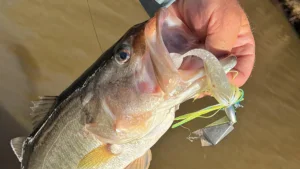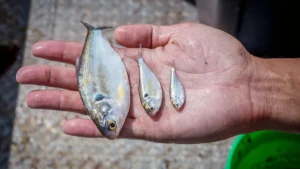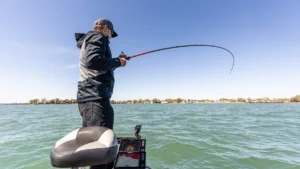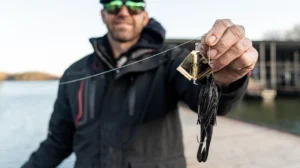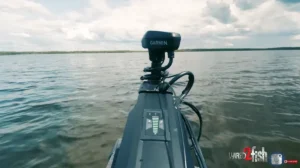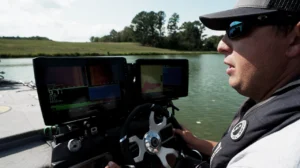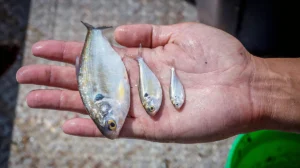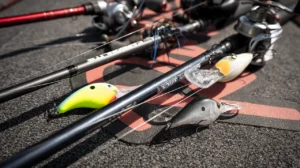I met Jacques Bordenave through the magic of the internet several years ago. I was blown away by photos of the flies he tied; wonderful deer hair concoctions that resembled some of the most iconic bass lures of all time. Not only did they look like those lures, but he managed to get them to provide similar action. Through impossibly tightly spun deer hair and carefully applied epoxy, silicone, and other tinctures, he got these bugs to behave just like the lures they drew their inspiration from. These fly rod lures looked great, and they caught fish.
Jacques’ fly-tying addiction reached an apogee in the early 2000s when retirement allowed him more time to pursue his passion. Around this time, the local bass began to exhibit less of a penchant for topwater presentations, so Jacques began tinkering with diving flies based off of Whitlock’s Swimming Frog. He tied dozens of them; when he was satisfied with their action, he sent 18 to one of his favorite authors, John Gierach.
Gierach was so impressed he wrote of them in All Fishermen Are Liars, stating that ‘These were some of the most flawlessly tied deer-hair bugs I’ve ever seen’ (All Fishermen Are Liars, page 178). Being the proud owner of a few, I can assure you Gierach is not being hyperbolic. They are the densest deer hair bugs I have ever encountered, and feature detail in their trimming I have never seen before. These are functional works of art that excel in their original purpose: catching fish.
I had the chance to chat with Gierach about Jacques’ bugs a few years ago; he was enamored with the “flawless craftsmanship that you have to see to believe.” He said he was “torn between keeping these bugs pristine because they’re so beautiful and fishing them because they work so well. So far, fishing has won.”

Bass Fanatic
Fly fishing was king of the bass scene until American GIs returned back to the States with a new style of reel after World War II. When in France, the Doughboys became enamored with a fixed-spool reel that allowed you to propel baits much lighter than the revolving spool, or bait casting reels of the time.
Soon, reels from French makers such as Luxor (imported by Bache-Brown) and the now-iconic Mitchell flooded American sporting goods stores. Thanks to their simple and rugged designs, many ancient Luxor Cracks and vintage 302 Mitchells can still be found plying the Striper Coast to this day.
But the flow of tackle wasn’t only one-way, at least for one small boy growing up in the Bordeaux region of France. Jacques was born into a family of fishermen, tossing a line into a warmwater river at the tender age of six. He started fishing for coarse fish with a simple cane pole in the 1940s and graduated to spin fishing for pike and perch in his teens, with an occasional jaunt to mountain streams to pursue trout. But he was most intrigued with an exotic species known locally as Black Bass.
Largemouth bass were introduced into a few French rivers in the late 19th century, but they really began to prosper around U.S. military bases after WWII, with many attributing their proliferation to the GIs. Rumors abounded of bass smuggled on cargo planes, and placed in the local waterways. Whatever their origin, there was more bass in France to pursue.
Jacques came upon a 1947 issue of Field & Stream magazine, which quickly became one of his most prized possessions. That dog-eared issue gave him his first glimpse into the American fishing world and set him on a path to become a dyed-in-the-wool bass addict.
He became very fond of the new American lures created for spin fishing; he bought a Heddon Midget Digit and a River Runt in Hardy’s of London in 1957. After obtaining a political science degree, Jacques was awarded a scholarship for a two-month trip to the States. He used some of that time to stock up on offerings from Heddon and Arbogast, especially his favorites: the Hula Popper and Jitterbug.
Eventually, he decided angling with a fly rod was the pinnacle of fishing. He even attempted to throw bucktails and salmon flies on his spinning rod until 1963 when he could finally afford a split bamboo rod, silk line, and a U.S.-made automatic reel.
Initially, he pursued trout with dry flies, relishing each rise. But after two years of Peace Corp-like service in Africa where he chased Tigerfish and Nile Perch in the Niger River, his passion for bass was renewed.
When Jacques returned home, he discovered that the bass population in his local river had exploded thanks to the construction of a new power-generating dam, which had formed a lake. This fishery was largely ignored, with most anglers choosing to pursue walleye so they can keep a few for the table.
He ditched the spinning gear in favor of specialty fly tackle; the first to do so on the river, and possibly the first in France. He took the techniques that made him a successful gear angler and applied them to the fly rod, learning to skip his bugs under downed timber and other structures. Still the topwater aficionado, he fished barbless poppers almost exclusively. It was clear: fly fishing for largemouth bass was Jacque’s calling.

Self-Taught Master
In the days before YouTube, and before magazines like Fly Tyer hit newsstands, there was little in the way of instructional materials available to aspiring tyers. So Jacques purchased his trout flies from local pros, and assembled poppers from scavenged materials and feathers from the henhouse.
He didn’t receive any real instruction until he saw a series of articles by the legendary Dave Whitlock in Bassmaster magazine around 1980, complete with detailed step-by-step drawings.
He would later discover Tim England through Fly Tyer, along with flies like the Banana Bug, June Bug, Gator Tail, and others. He bought up all the books he could find by masters such as Nixon, Waterman, Livingston, Ellis, and Tapply; and subscribed to every fly fishing and tying magazine he could.
But it was Tim England, and later Joel Stewart’s work, inspired by lures such as the Flatfish, Lazy Ike, and Lucky 13, that had the most profound effect on Jacques — so much so that he dug into his lure box and recreated the hard baits in deer hair.
My favorite of Jacques’ flies is the Jithairbug, an all-hair version of the Heddon classic. He originally tied England’s June Bug, but was disappointed with the fly’s action and durability. So he created a better mousetrap, building an epoxy lip for improved casting and durability over England’s mylar version. The more rigid structure also provides enhanced action, creating a louder pop when retrieved.
The earliest iterations were tied on TMC 8089 #6 and #2 hooks, but later versions were crafted on Tiemco 8089 Stinger hooks for improved hook ups, though like the original, getting a solid hook set can prove to be difficult. He has mostly remedied this by turning the hook point up, which has the added benefit of making the fly more weedless and providing better action and sound.
Since our first conversations, Jacques has started creating fly rod versions of French plugs. Most conventional anglers in France use spinners or spoons, so there wasn’t a lot to choose from. He started tying a copy of the Rublex FLOPY, a lure with a wobbling action. It was tied as a display piece, but testing revealed that it had a wonderful action, pulling under and floating back to the surface. It was responsible for Jacques’ first bass of the year, and now has a place in his fly box.

Functional Art
Spinning deer hair with the skill that Jacques does is beyond impressive, but to learn how to do so before the internet age, and its bounty of information, makes it even more so. Even with all those aids, my flies can’t hold a candle to his. He has a level of mastery few have ever achieved.
The flies he sent me are my favorites of all time, more than any others I’ve ever owned, or fished. One of his divers was responsible for more bass than any fly I’ve ever thrown. So much so that when a pike came up and gobbled it whole, I debated jumping out of the canoe and going after it with my bare hands.
I mentioned this incident to Jacques, telling him I’d become hesitant to fish the others he’d sent for fear of losing them. He responded by sending a few more, which were every bit their equal in appearance and performance.
Jacques recently celebrated his 83rd birthday by catching bass on one of his topwater bugs, an annual tradition. Happy birthday, and tight lines my friend. I swear, I do fish some of the bugs you’ve sent, but a few will remain behind glass, a testament to their status as art.


